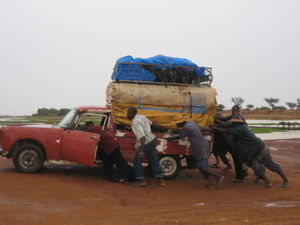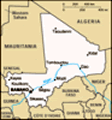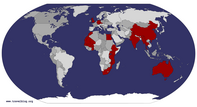Advertisement

 Pushing the ute
Pushing the ute
Me and a bunch of other strapping young men try to push our ute out of the mud, near Djenne. It didn't go much further after this.
Tom Griffith It doesn't rain much in Mali, but when it does, it pours. In the past week, we have seen three big storms, several dramatic duststorms, and, sadly, our first floods - and flood victims. But more on that later...
The rains first hit last Sunday, while we were on our way from Segou to Djenne, and the downpour caught us in the middle of a transport change in the middle of nowhere. We were forced to cower benath a tarp inside a wooden shack, neither of which provided much protection. Once the rain had died down a little, we attempted to cover the last 30km of our journey to Djenne. It took four hours. The car was an ancient Peugeot ute that looked like something out of a 1950s American movie. It had no windscreen wipers, dodgy brakes, and had to be push-started every time we stopped - which was all the time. We made it to the car ferry that plies the river before Djenne, but of course, it couldn't operate in the rain, so we waited some more there, in the mud and wet. Once we crossed the river, more pushing of our ute was required. We

 Cowboy
Cowboy
The boy on the bull, Dogon Countrylimped into the outskirts of Djenne, 4km away, an age later, and then the car finally died, stopped, finished. We were forced to grab our soaking packs and trudge the last kilometre into town. All this in the rain, mind you. And, just for your information, Djenne is famous for being constructed almost entirely from mud. Now, try and imagine what a mud town looks like after a prolonged thunderstorm...
Djenne was awesome, despite our - and the town's - bedraggled states. We stayed overnight in order to see the incredible Monday markets, a thriving, feverish hive of buying and selling that takes place in front of the bizarre and stunning Djenne mosque; made of - you guessed it - mud, and the largest mud edifice in the world. It was well worth the journey - Djenne was a true highlight of the trip so far.
From Djenne we travelled to the town of Bandiagara, via the city of Mopti. We were only in Mopti for two hours, but it was enough time for it to live up to its crappy reputation - we were accosted by an angry drunk for the whole time, who made it quite

 Djenne Mosque
Djenne Mosque
A group of market traders hang outside the amazing Djenne Mosqueclear, despite the slurring, what he intended to do with us if we ever crossed his stumbling path again.
Bandiagara was to be our base for a trek into the Dogon Country - perhaps the most popular tourist destination in Mali, and quite unique as places go. The area is special both for culutural, and aesthetic, reasons. The Dogon Country is centred around the dramatic Falaise de Dogon, or Dogon Escarpement, which kind of resembles a cross between Kakadu and the African savannah, and makes for some great trekking landscape. On top of that, the Dogon are one of the few West African tribes who have resisted colonisation, or westernisation, or modernisation, whatever politically incorrect term you wish to use. Many of the Dogon villages - especially those built along the escarpement itself - still live largely traditional lifestyles, and practise their ancient culture and animist religion. This is one of those places where you can meet a real African chief, or see animal fetishes on display at someone's house, or watch kids pounding millet for the evening meal.
Now, before I go on, let me explain something. If this all sounds a bit like Disneyland, with white

 Mosque 'n' cloth
Mosque 'n' cloth
A cloth stall in front of the Djenne Mosquetourists parading around a bunch of traditional villages, gawping at bare-breasted African women chewing kola nuts, then you'd be pretty spot on. The whole thing is a bit of a display, and you feel like a real voyeur being there. Not to mention the alienating effects of mass tourism on these people. Twenty years ago, many Dogon had never seen rice, or soft drinks, let alone electric lights and David Beckham T-shirts. All these whities traipsing around, expecting hotel rooms, and Coke, and beer, and spaghetti for dinner, are having a huge impact on a culture that has changed little over the centuries.
However, on the upside, you pay a bomb to trek the Dogon, and every village you visit charges you a tourist tax, which allows you to wander around and take photos. The tax goes to fund such 'good' utilities as wells, clinics, and schools. You also require a local guide to help you negotiate the complexities of talking with elders, avoiding sacred sites, and arranging meals and accomodation - and this brings employment to a many young Dogon men. So tourism does bring some positive things to this spectacular area.
The point is - never

 Djenne Mosque and markets
Djenne Mosque and markets
The mud mosque with the weekly markets in the foreground, Djennehave we felt so much like a pair of naive tourists. I guess we shouldn't think too hard about it and hope that the Dogon prove as resistant to soccer and rap music, as they did to French imperialism. If, that is, they want to resist such things.
Anyway, moral issues aside, the whole trek was a superb experience, apart from my dodgy guts (probably the local millet beer made with well-water), and the scorpion that tried to climb into bed with me (well done Suze and her stampy foot for averting disaster). Our guide, Robert, was brilliant, and looked after us as though we wer his children. The escarpement and ethereal Dogon villages were a feast for the eyes. The Dogon themselves were welcoming and friendly. And sleeping under the stars, with the sounds of braying mules, bleating goats, and crowing roosters, echoing off the cliffs above us - magical.
We spent four days in the Dogon, and then returned to Bandiagara, to stay one more night at the hotel where we had left our stuff. We couldn't believe the sight that greeted us as the taxi pulled up in town. Every house in our street, except

 Mango truck
Mango truck
The mango sellers at the Djenne marketsthe hotel, had collapsed. The bridge spanning the river a hundred metres away lay twisted and broken. Crowds of people were gathered at the water's edge, bathing, washing clothes, or searching for belongings. The place was a mess of mud and debris.
The first night we had left town, a huge thunderstorm had hit the area. The river had swollen, broken its banks, and washed into the nearby residential area. When it receded, every house constructed of mud had simply fallen down. A hundred houses in all, leaving hundreds of locals homeless. Our hotel, made of cement, had survived - but all water and electricty supplies were down, and the hotel had become home to a bunch of families displaced by the flood. It was an absolute tragedy to behold.
We stayed one night at the hotel, unable to do much, as in the preceding three days all that could be done, had been done. There was no point in rebuilding any of the collapsed houses, as the rainy season lasts for another few months, and the same could easily happen again. So we sat around in the dark, feeling useless.
That night, there was another storm.

 View over Djenne
View over Djenne
The view across the Djenne marketsI woke at midnight and checked the situation. The refugees had moved up to the first floor, as the river had once again breached its banks, and the waters were swirling into the ground floor of the hotel. I had nightmare images of us all having to climb onto the roof to await rescue, but luckily for everyone, the river went down again by morning.
That was our last experience of Mali. A tough country to travel, a tougher one in which to live. But such brave, resilient people who manage to do so. The wonderful Malians do not deserve their lot.
Tom and Suze's Top Six of Mali
1. The Dogon Country. Surreal landscapes, traditional village life, and even the odd real, authentic, African chief or shaman. Brilliant.
2. Bamako. As African capital cities go, this one ain't half bad.
3. Djenne. The world's largest mud building - the Djenne mosque - overlooks the sensory-overloading markets held here every Monday. Pure Mali.
4. The Mission Catholique, in Bamako. One of the cleanest and friendliest places we've stayed in West Africa.
5. The Malians. Generally, these folks are friendly, open and love a

 Jonesy and me
Jonesy and me
Suze and me posing above the Djenne marketsjoke, and get on by, despite the hard lives they have to live. And most of the men also seem to want to be your guide, but we'll ignore that.
6. The political clothes. Politicians here give out free T-shirts and cloth bearing their slogans and likenesses. And everyone is so poor, they wear them; Every person in Mali is a walking political advertisement. ATT - pour un Mali qui gagne!
Tom and Suze's Bottom Four of Mali
1. The weather. Too hot by far in the west, too wet by far in the south. If it wasn't humid, then there was a dust storm, or even a flood. Not a great time to come to Mali...
2. The tourist touts of Segou. These persistent guys spoil an otherwise lovely town.
3. Malian transport. Some of these cars and buses would have been condemned 20 years ago in Europe, but they've found a second life over here. Shame that life now involves being push-started and dangerously overloaded with people.
4. The poverty. No child in the world should have to beg for my scraps of chewed-up goat meat so that they can avoid hunger.

 The Millet Pounder
The Millet Pounder
One little Dogon girl, pounding her millet...***
Africa Country Count: 6
Mali Overland Kilometre Count: 1575km
Africa Overland Kilometre Count: 13,800km
Next Country: Burkina Faso
Advertisement
Tot: 0.289s; Tpl: 0.015s; cc: 24; qc: 115; dbt: 0.1398s; 1; m:domysql w:travelblog (10.17.0.13); sld: 2;
; mem: 1.4mb






















Ontheroad
Eric & Mike
Dogon and beyond
This time last summer I was on my way to Dogon Country from Burkina. It was amazing. Great to reminisce. If you haven't left Mali yet you may want to consider a trip to Mopti and then to timbulto. It was one of the more memorable journeys on my 2 1/2 mo. trip through w. africa. Travel on!!